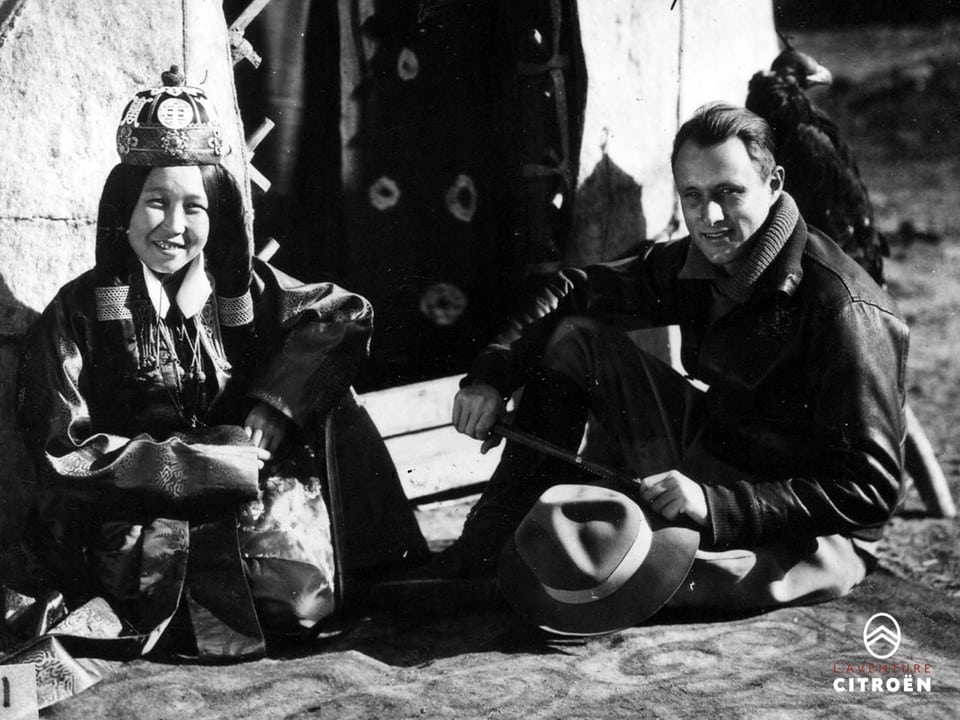
The Princess and Citroën
Discover the tale of a Princess meeting Citroën...
The Yellow Cruise, which took place from 4 April 1931 to 12 February 1932, also known as the « Central Asia Mission » or « Third G.M Haardt – Audouin-Dubreuil Mission » was one of the automobile treks organised by André Citroën. It involved driving half-tracks from Beirut to Peking with mechanics, photographers and film makers as well as scientists on board. A 13,000 km trip of discovery and accounts of the costumes and the monuments erected by the peoples of the Middle East, Asia and also Indochina.
Every trip is fraught with danger, one of them being the halt at Ouroumsti, on the border with the province of Xinjiang with the China Group from July to November 1931, and a part of the Pamir Group (travelling 1,400 km on horseback to join them, the other part returning with the half-tracks and the collections). Princess Nirgidma was also there and hoped to obtain a passport to cross the province. The wait at Ouroumsti was very long. As long as there weren’t a handful of TSF radios and the three half-tracks that had been ordered, the Governor, General King, refused to let the members of the Yellow Cruise party leave the city. The situation was all the more delicate as politicians, such as Soviet Consul M. Smirnoff, were worried that war between the Chinese and the Japanese would break out. It did eventually six years later and lasted until the end of 1945. On 19 September 1931 Japan invaded Manchuria, in eastern China.
In some ways, the team was being held prisoner. Without passports it could do nothing. Eventually, on 19th November, there was good news : the French obtained a group passport, « an impressive document. As large as the Declaration of Human Rights, written on tissue paper covered with stamps and signs which for us were indecipherable. Ther was only one identity photograph : that of Georges-Marie Haardt ».
Maynard Owen Williams, famous journalist of the National Geographic Society, was one of the adventurers and had the pleasure of photographing and talking with Princess Palta.
Thus Citroën acted as a vector to convey to Westerners the Eastern culture and way of life when its photographs, paintings, films and diverse collections of objects were put on display when the expedition returned home.
Portrait of the Princess
Princess Palta (Nirgidma de Thorout) was born in 1908. Her father reigned over the Torgut tribes in Mongolia, around 150,000 people at the time, and was also Governor of Altai, before becoming Senator of the Republic of China. Her two brothers studied in Germany and Russia. Nirgidma also received an extensive education, at the Sacré-Cœur school in Peking (alongside her sister, who died at the age of 17), then at the medical school in Brussels (where her beauty and her quick wit were appreciated by the intelligentsia) and in Paris. She could thus speak Chinese, English, French and Russian.
She counted Father Teilhard de Chardin among her friends after their first meeting in 1926 at the archaeological digs he was conducting in China. On her return from Europe she settled into the nomadic lifestyle of her people, with yurts, yaks and Buddhist spiritualism.
In 1938 Princess Palta married a diplomat, Michel Bréal, France’s Consul General in Shanghai, who went on to become Ambassador to Afghanistan (1952 – 1954), to Laos (1954 – 1955) and Thailand (1958 – 1959). They lived a cosmopolitan lifestyle in France. She was the great-aunt of Tsem Tulku Rinpoché, a reincarnated Lama who had been adopted by an American family (his family having fled Central Asia in 1949).






